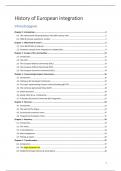Summary
Samenvatting History of European Integration (B-KUL-HMH39F)
- Course
- Institution
Chapter 0 : introduction Chapter 1 : What kind of Union? Chapter 2 : Europe of the communities Chapter 3 : Constructing European Community Chapter 4 : Reversal Chapter 5 : Recovery Chapter 6 : Transformation
[Show more]



